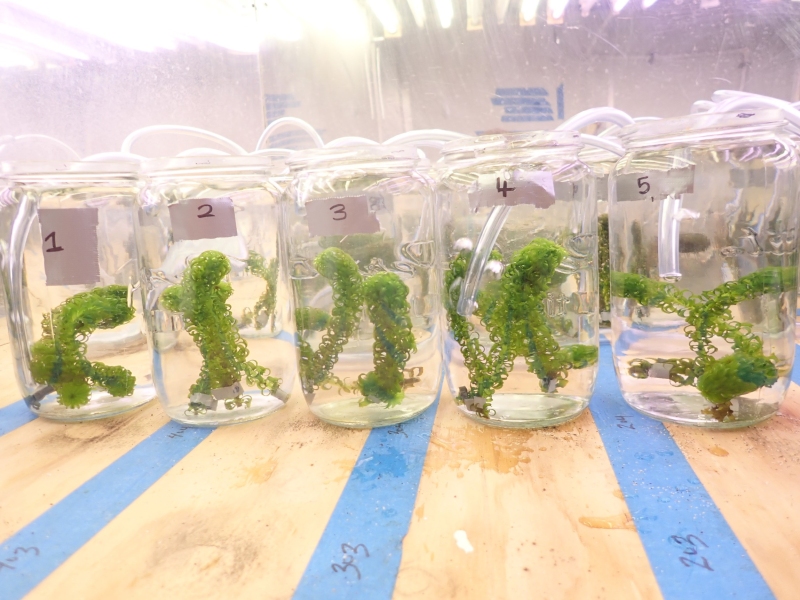In Aotearoa New Zealand, the control of well-established invasive aquatic weeds in lakes is most often undertaken with herbicides because it is cost effective. Herbicide use leaves the treated weed biomass decaying in the waterbody.
Most herbicide treatments are in still waters such as lakes or hydro-power dams and some lake managers have asked about the fate of the nutrients from the decaying plants and whether they have a role in fueling algal blooms.
There are both ecological and anthropogenic reasons for controlling invasive aquatic weeds. Invasive aquatic weeds can have significant negative impacts on aquatic ecosystems, contributing to the degradation of water quality, reduced native biodiversity, and restricting hydropower generation, irrigation, and drainage. Excessive weed growth also impedes recreation such as swimming and boating.
“There’s a lot of contention around herbicide use – and some lake managers feel that when they do treat with herbicides, the subsequent weed bed decay could contribute to algal blooms,” said Ben Woodward, NIWA Biogeochemist.
“However, it’s all anecdotal, there have been no actual studies and there’s nothing in the literature to prove whether this is actually occurring,” he said.
A team of NIWA Freshwater scientists undertook research to investigate these questions.
What was the study trying to achieve?
“In this study, we want to find out if you kill lagarosiphon (Lagarosiphon major, a submerged invasive weed) with the herbicide, does it release the nutrients it contains, how much of its nutrients does it release, and how long after treatment are the nutrients released?” Woodward said.
“The ultimate aim of this research is to help with lake health and weed management” said Woodward.
“We want to enable lake managers to make better predictions around what the impacts of treating large weed beds with the herbicide diquat will be on lakes and if there is a risk that these treatments contribute to algal blooms.”
What did the experiment involve?
They treated lagarosiphon shoots with 11 different concentrations of the commonly used herbicide diquat at NIWA’s Ruakura Aquatic Research Facility in Hamilton.
The concentrations ranging from 0 to 1 mg l-1 were maintained for three different exposure times of 1, 10 and 100 minutes. After treatment, five lagarosiphon shoots were placed into 1 L jars filled with tap water and concentrations of total nitrogen (TN) and total phosphorous (TP) in the water column were periodically measured over the following 21 days.
During this time, lagarosiphon decay was monitored and visible signs of decay were recorded on a scale of 0 to 5, with 0 - green and healthy, 1 - discoloured or dull, 2 - loss of turgor, 3 - fragmentation, 4 - collapsed, and 5 – dead. TN and TP concentrations were converted to masses and normalised to the estimated lagarosiphon biomass within each jar. Using this data, we then calculated TN and TP release rates and loads of TN and TP released during each of the different stages of decay.
Across all diquat doses and exposure times the majority of TN and TP contained within the decaying lagarosiphon biomass was released into the water column while the plants still appeared to be healthy or were slightly discoloured (i.e., within a few days after treatment). A greater proportion of the TP contained in the plant was initially released compared to the TN content. This is because the less structural parts of the plant, such as leaves, and new shoots are initially more affected by the diquat treatment and have higher TP content than the more structural cells that are affected later in the decay process. The lower TP content of the more structural cells is also evident during the loss of turgor (2), fragmentation (3) and collapse (4) stages of decay as the TP previously released into water column was being utilised in the decaying biomass, resulting in decreasing water column TP concentrations. TN continued to be released during these later stages of decay and is further evidence of the higher N:P ratio of the structural cells. It was not until the plants were observed to be ‘dead’ that TN concentrations in the water column started to decline indicating the decaying biomass was taking N from the water column.
What were the conclusions of the study?
The NIWA study found that nutrients were released a lot faster than we thought they would be.
“We assessed the health of the plants from healthy to dead on a scale of zero to five and most of the nutrients were being released while the plants were still looking healthy or just slightly effected by the herbicide,” Woodward said.
“This finding was really interesting because it’s intuitive to expect that it wouldn’t be until the plants were dead or collapsing that you’d actually get the largest releases of nutrients into the water,” he said.
“But in fact, in the latter stages of decay the decaying biomass of the weeds actually became a sink for nutrients, it was pulling nutrients back out of the water column.”
“This is because the herbicide, diquat works by hijacking the photosynthetic process, and creates a free radical inside the cell of the plant, which then breaks the cell wall open, then the contents of that cell is released into the water- that’s the cause of the nutrient release,” Woodward explained.
“This study indicates, herbicide treatment of shoots results in a very quick release of nutrients initially for about two or three days and the rest of the decaying biomass over the next two weeks becomes a sink and takes-up nutrients.”
Has this answered the question about whether herbicide treatment of aquatic weeds will contribute to the risk of an algal blooms?
Not yet, this is just one small piece of the puzzle. We will be doing other studies as well to be able to answer the question more thoroughly. For example:
We answered the question on the timing of nutrient release – it’s early in the decay process.
We haven’t yet answered what is the fate of these nutrients when released in a lake or whether the nutrient release could contribute to the risk of algal blooms. That is why additional experiments are needed that go beyond small shoot tips of a plant (which are sensitive to the herbicide), to including lake sediments, more than one species and consider whole weedbeds.
Ultimately this sort of information will get put into lake specific models that also have data on background nutrient and chlorophyl a levels, temperature, light availability, and water residence time. These are all factors that contribute to the risk of an algal bloom, whether weeds are present in a lake or not. By combining this information, we can start to make better predictions as to whether or not decaying weed-beds post-herbicide treatment could contribute to the existing risk of an algal bloom.
The goal of this research, to which this study contributes, is to enable managers to make more robust assessments and decisions. For example, if there were a risk, assessments could include whether changing the treatments to a different (cooler) month would provide effective weed control and reduce any potential risk of a bloom, ultimately providing better outcomes for lake health.
Useful links:
- More detail about this study can be found in our recent publication here.
- Diquat use for submerged weeds
Funding:
This research was undertaken with Strategic Science Investment Funding allocated to the NIWA Freshwater Biosecurity Programme (FWBS2402).
For more information on this project, contact Deborah Hofstra: [email protected]



